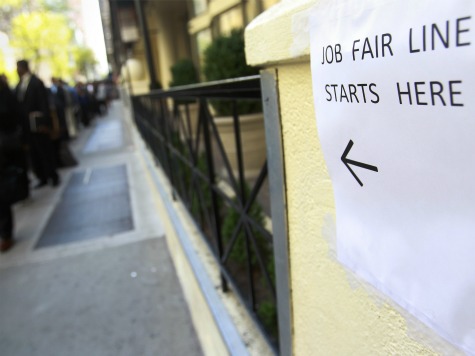Friday, forecasters expect the Labor Department will report the economy added 175,000 jobs in July, down from 195,000 in June, and the unemployment rate will slip a notch to 7.5 percent.
The pace of job creation has been stronger in recent months; however, a noticeable shift toward replacing full-time workers with part-time employees masks a much tougher market for job-seekers. Since January, 833,000 more Americans reported working part-time, while 97,000 fewer have full time positions.
This is not surprising–a good deal of the new jobs are in the hospitality, retailing, and other sectors where businesses may chop up full-time positions to avoid rising heath insurance costs for full-time employees mandated by ObamaCare.
More part-time workers pushes down wages for ordinary workers and is one particularly poignant illustration of a public policy initiative intended to reduce income inequality that actually exacerbates it.
Under more normal circumstances, about 360,000 additional jobs would be needed each month to pull down headline unemployment to 6 percent, but to attain a truly healthy labor market many more full time jobs are needed.
Adding in discouraged adults and part-timers who want full-time positions, the unemployment rate becomes 14.3 percent.
Slow growth is the ultimate factor behind income disparities.
In the second quarter, GDP was up only 1.7 percent and has averaged a paltry 1 percent since President Obama’s reelection.
Despite greater optimism expressed by consumers in sentiment surveys, real consumer spending, net of autos, has softened. $200 billion in higher taxes imposed at the beginning of the year dwarf sequester spending cuts and have severely limited consumer spending on nonessentials.
Businesses remain quite pessimistic and investment remains subpar, dragging down growth. Obama’s proposal to tighten up and raise corporate taxes for more jobs programs–especially given the poor record of his targeted initiatives in alternative energy and vehicles–only adds to investor skepticism.
Long-term, the president’s proposal to further tax overseas corporate earnings, when other principal nations do not, will motivate more firms to move corporate headquarters and jobs to Ireland and other low-tax jurisdictions. Eaton, Sara Lee, and many less well-known companies have already done so.
Major factors contributing to the slow pace of recovery include the huge trade deficits on oil and manufactured products from China, Japan, and elsewhere in Asia–these slow demand for U.S. goods and services. Absent U.S. policies to effectively confront Asian governments about their purposefully undervalued currencies and to develop more oil offshore and in Alaska, the trade deficit will continue to tax growth.
An artificially cheap yen will eventually undermine the auto-sectors recovery. It raises Japanese auto makers net on new cars by at least $2000, which they can pour into incentives, more features and product development. The latter will have particularly insidious consequences for Detroit’s ability to compete in the emerging hybrid and electric segments.
The recent surge in natural gas production, and accompanying lower prices, improves the competitiveness of energy-using industries like petrochemicals, fertilizers, plastics, and primary metals–as well as their consuming industries like industrial machinery and building materials. However, Department of Energy efforts to boost exports of liquefied gas will reduce the trade deficit and boost growth much less, and create many fewer jobs, than keeping the gas in the United States for use by energy-intensive industries.
Dodd-Frank regulations make mortgages, refinancing, and home improvement loans much more difficult to obtain. The recovery in housing construction, though welcomed, remains lackluster as compared to past recoveries.
The high cost and slow pace of regulatory reviews are a constant complaint among businesses and dampen investment spending–and Washington shows no signs of listening. Government needs to subject policies to protect the environment and other regulatory goals to the same efficacy standards the market applies to commercial technologies–regulatory assessments and enforcement are needed but those must be delivered cost effectively and quickly to add genuine value.
Without better trade, energy, tax, health care, and other regulatory policies, stronger growth and the creation of enough good jobs are simply not going to happen.
Peter Morici is an economist and professor at the Smith School of Business, University of Maryland School, and a widely published columnist. Follow him on Twitter.

COMMENTS
Please let us know if you're having issues with commenting.